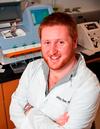Technologies
Competitive Advantages:
Chemo diversity, enhanced conformational rigidity, and greater protease resistance, Increased conformational constraint and binding affinity, Proven method of drug discovery.
A one-bead-two-compound combinatorial synthesis technique provides libraries of macrocyclic peptidomimetic compounds and compositions with use as ligands for the Ephrin type-A receptor 2 (EphA2). The one-bead-two-compound technique and libraries of macrocyclic compounds are useful as research tools in drug discovery and/or to treat or prevent a range of diseases or disorders.Combinatorial chemistry serves as a powerful tool for ligand screening against potential protein and peptide targets. However, macrocyclic peptidomimetic combinatorial libraries are virtually nonexistent. Described is a new class of peptidomimetic macrocyclic combinatorial library which provides a novel method of drug discovery. The library is based on the use of peptide mimicking molecules with ?-AApeptide backbones and macrocyclic functional groups for binding specific biological targets. The advantages are the unique structure of its ligands as macrocyclic and peptidomimetic molecules. The ?-AApeptide backbones ensure chemo diversity, enhanced conformational rigidity, and greater protease resistance. This has been used successfully to identify a ligand targeting receptor tyrosine kinase, a protein involved in melanoma, ovarian, breast, and lung cancers, but has unlimited applications.
Competitive Advantages:
Potent antimicrobial activity against resistant bacteria, Effective on both gram positive and negative bacteria, Can penetrate bacterial biofilm, Combat emerging threats of drug-resistant bacteria.
Provided are novel bis-cyclic guanidine compounds, and the use thereof for treating bacterial infection.Scientists at USF have designed novel bis-cyclic guanidine compounds that kill bacteria by compromising their cell membranes. Their mechanism of action is analogous to that of HDPs (host-defense peptides) which have recently surfaced as an alternative approach to fight bacterial resistance. Furthermore, these compounds exhibited excellent in vivo activity in methicillin-resistant Staphylococcus aureus (MRSA) infected mice. Even after 14 consecutive passages of bis-guanidines, MRSA did not show signs of developing resistance against these compounds. It could even penetrate the normally drug resistant biofilm. Thus, indicating that bis-cyclic guanidines can act as potent membrane-active antibacterial agents, which can effectively kill multidrug resistant bacteria. This technology manifests an appealing class of antibiotic agents that can lead the fight against hospital and community-acquired infections.
Competitive Advantages:
Potent antimicrobial activity against resistant bacteria, Effective on both gram positive and negative bacteria, Can penetrate bacterial biofilm, Combat emerging threats of drug-resistant bacteria.
Provided are novel bis-cyclic guanidine compounds, and the use thereof for treating bacterial infection. Scientists at USF have designed novel bis-cyclic guanidine compounds that kill bacteria by compromising their cell membranes. Their mechanism of action is analogous to that of HDPs (host-defense peptides) which have recently surfaced as an alternative approach to fight bacterial resistance. Furthermore, these compounds exhibited excellent in vivo activity in methicillin-resistant Staphylococcus aureus (MRSA) infected mice. Even after 14 consecutive passages of bis-guanidines, MRSA did not show signs of developing resistance against these compounds. It could even penetrate the normally drug resistant biofilm. Thus, indicating that bis-cyclic guanidines can act as potent membrane-active antibacterial agents, which can effectively kill multidrug resistant bacteria. This technology manifests an appealing class of antibiotic agents that can lead the fight against hospital and community-acquired infections.
Competitive Advantages:
Treats underlying cause of AD instead of just treating symptoms, Disrupts the aggregation of AD-causing proteins, Has the potential to prevent or reverse AD and other related neurodegenerative diseases.
Disclosed herein are compounds for the treatment of neurodegenerative diseases and compositions comprising the same.Alzheimer’s Disease is a complex neurodegenerative condition that afflicts 25 million people worldwide. Current drugs produce minor improvement of symptoms without preventing or reversing AD’s progression. Three proteins have been identified in the onset of similar neurodegenerative conditions: amyloid beta peptides, tau peptides, and synuclein. Their aggregation in the brain is related to the onset and persistence of AD, yet no current drugs or therapies target them. This new ligand, HW-C-9, disrupts the aggregation of amyloid beta peptides, tau peptides, and synuclein. It also removes the plaques formed by them. This promising molecule can be used for the diagnosis, prevention, and cure of AD and other related neurodegenrative diseases.







































